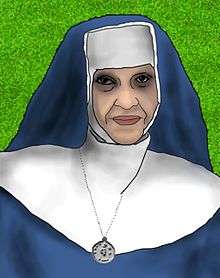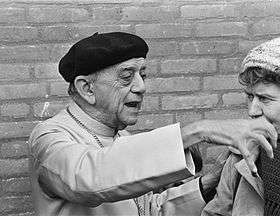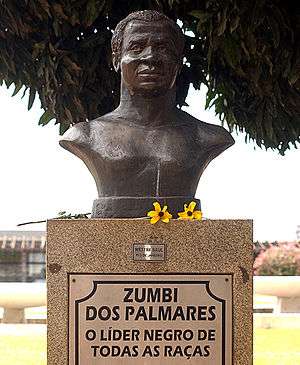Calendar of saints (Episcopal Anglican Church of Brazil)
The calendar of saints of the Episcopal Anglican Church of Brazil (Igreja Episcopal Anglicana do Brasil – IEAB) follows the tradition of The Episcopal Church (TEC), from whom it was a missionary district until 1965.[1] TEC's calendar of saints, in turn, has its origins in the calendar of the Church of England and in the General Roman Calendar. As such, IEAB commemorates many of the figures present in the Roman Calendar, most of them on the same dates, but it also commemorates various notable Post-Reformation uncanonized Christians, especially those of Brazilian origin.
The only person canonized in a traditional sense since the English Reformation was Charles I in 1660 (commemorated on 30 January), although he is not widely venerated as a saint by most Anglicans.[2] The Anglican Communion has no mechanism for canonizing saints, and unlike the Catholic Church it makes no claims regarding the heavenly status of those commemorated in its calendars.[2] For this reason, IEAB avoides the use of the prenominal title "saint" with reference to uncanonized figures. In order not to imply degrees of sanctity or to discriminate between canonized and uncanonized persons, the title "saint" is not used at all in IEAB's calendar, even with reference to those who are generally known by that title, such as the Apostles or the early Christian saints.
There is no single, unified calendar for the various provinces of the Anglican Communion; each makes its own calendar suitable for its local situation. As a result, the following calendar contains some important figures in the history of Brazil, such as Black warrior Zumbi dos Palmares, Native warrior Sepé Tiaraju, and environmentalist Chico Mendes.[3] At the same time, there are figures from other provinces as well as post-Reformation Catholics, such as nun Dulce Pontes.[3] The most recent edition of the calendar, elaborated by IEAB's Liturgical Commission for the liturgical year which has started on Advent Sunday (30 November 2014), tried to balance the number of male and female figures.[3] The holy days are divided in principal feasts, festivals and lesser festivals.[3] To settle any doubts regarding the sanctity of post-Reformed, uncanonized figures, all of them are commemorated in lesser Festivals, whose celebration is optional. The typography shows the level of the observance: BOLD CAPITALS denote principal feasts, Bold denotes festivals, and roman denotes lesser festivals.[3]
Movable Feasts
- First Sunday after Epiphany: BAPTISM OF OUR LORD JESUS CHRIST
- First Wednesday 46 days before Easter: Ash Wednesday
- Thursday before Easter: Maundy Thursday
- Friday before Easter: Good Friday
- 22 March—25 April: EASTER SUNDAY
- 40th day of Eastertide: ASCENSION OF OUR LORD JESUS CHRIST
- 50th day of Eastertide: PENTECOST
- First Sunday after Pentecost: HOLY TRINITY
- Sunday before Advent: FEAST OF CHRIST THE KING OF UNIVERSE
January
- 1 THE HOLY NAME AND CIRCUMCISION OF CHRIST
- 2 Basil and Gregory, Bishops and Doctors of the Church, 379 e 389
- 6 EPIPHANY
- 10 William Laud, Archbishop of Canterbury and Martyr, 1645
- 13 Hilary of Poitiers, Bishop and Teacher of the Faith, 367
- 17 Antony, Hermit and Abbot in Egypt, 356
- 18 Confession of Peter the Apostle
- 20 Fabian, Bishop and Martyr, 250
- 21 Agnes, Martyr, 304
- 22 Vincent, Deacon and Martyr, 304
- 23 Sumio Takatsu, Bishop and Teacher of the Faith, 2004
- 24 Francis de Sales, Bishop and Teacher of the Faith, 1622
- 25 Conversion of Paul the Apostle
- 26 Timothy, Titus, and Silas, Companions of Paul the Apostle
- 27 Lydia, Dorcas, and Phoebe, Witnesses to the Faith
- 28 Thomas Aquinas, Priest and Teacher of the Faith, 1274
- 29 Andrei Rublev, Monk and Iconographer, 1430
- 30 Charles Stuart, Martyr, 1649
- 31 Juan Bosco, Priest and Educator, 1888
February

- 1 Brigid of Kildare, Abbess, 523
- 2 PRESENTATION OF OUR LORD JESUS CHRIST AT THE TEMPLE
- 4 Ansgar, Missionary to Denmark and Sweden, 865
- 4 Cornelius the Centurion, 1st century
- 6 The Martyrs of Japan, 1597
- 7 Sepé Tiaraju, Prophetic Witness, 1756
- 10 Scholastica, Nun, c. 543
- 12 Dorothy Stang, Nun and Martyr of the Amazon rainforest, 2005
- 13 Absalom Jones, First Black Priest of the Anglican Communion, 1818
- 14 Cyril, Monk, and Methodius, Monks and Bishops, Missionaries, 869, 885
- 14 Valentine, Martyr, c. 269
- 15 Thomas Bray, Priest and Missionary, 1730
- 17 Janani Luwum, Archbishop of Uganda, and Martyr, 1977
- 18 Martin Luther, Reformer, 1546
- 23 Polycarp, Bishop and Martyr, 156
- 24 Matthias the Apostle
- 26 Florence Li Tim-Oi, Priest and Prophetic Witness, 1992
- 27 George Herbert, Priest and Poet, 1633
March

- 1 David, Bishop, c. 601
- 2 Chad, Bishop, 672
- 3 John and Charles Wesley, Priests and Reformers, 1791, 1788
- 7 Perpetua and Felicity, Martyrs, 202
- 8 Carman Wolff Hunter, Missionary and Educator, 2000
- 9 Gregory, Bishop, c. 394
- 9 Olavo Ventura Luiz, Bishop, 1993
- 12 Gregory the Great, Bishop of Rome, 604
- 13 James Theodore Holly, Bishop, Missionary and Prophetic Witness, 1911
- 13 Dulce of the Poor, Nun, Missionary and Prophetic Witness, 1992
- 17 Patrick, Bishop and Missionary, c. 460
- 18 Cyril, Bishop and Teacher of the Faith, 386
- 19 Joseph of Nazareth
- 20 Cuthbert, Bishop and Missionary, 687
- 20 Thomas Ken, Bishop and Musician, 1711
- 21 Thomas Cranmer, Archbishop of Canterbury and Martyr, 1556
- 24 Oscar Romero, Archbishop and Martyr, 1980
- 25 ANNUNCIATION OF OUR LORD JESUS CHRIST TO THE BLESSED VIRGIN MARY
- 27 Charles Henry Brent, Bishop of the Philippines, and of Western New York, 1929
- 29 John Keble, Priest and Reformer, 1866
- 31 John Donne, Priest and Poet, 1631
April
- 1 Frederick Denison Maurice, Priest and Teacher of the Faith, 1872
- 3 Richard, Bishop, 1253
- 4 Martin Luther King Jr., Civil Rights Leader and Martyr, 1968
- 5 Pandita Mary Ramabai, Missionary, 1922
- 9 Dietrich Bonhoeffer, Teacher of the Faith and Martyr, 1945
- 10 William Law, Priest and Teacher of the Faith, 1761
- 12 Nilde Cunha, Priest, 2002
- 21 Anselm, Archbishop of Canterbury and Teacher of the Faith, 1109
- 22 Mary Packard, Missionary, 1940
- 23 George, Martyr, c. 304
- 24 Martyrs of Melanesia, 2003
- 25 Mark the Evangelist
- 29 Catherine of Siena, Teacher in Faith, 1380
May
- 1 Philip and James, Apostles¹
- 2 Athanasius, Bishop 373
- 4 Monnica, Keeper of the Mission, 387
- 5 Ordination of women in the Episcopal Anglican Church of Brazil, 1985
- 8 Julian of Norwich, Mystic, c. 1417
- 16 Martyrs of Sudan, 1983-2005
- 19 Dunstan, Archbishop of Canterbury, 988
- 20 Alcuin, Deacon and Teacher of the Faith, 804
- 21 Helena, Keeper of the Mission, 330
- 25 Bede, the Venerable, Monk and Historian, 735
- 26 Augustine, First Archbishop of Canterbury, 605
- 27 John Calvin, Reformer, 1564
- 28 Lanfranc, Prior, Archbishop of Canterbury and Teacher of the Faith, 1089
- 31 The Visitation of the Blessed Virgin Mary
¹ James may also be commemorated individually on 23 October.
June
- 1 First service of the Episcopal Anglican Church of Brazil, 1890
- 1 Justin, Martyr, c. 167
- 2 The Martyrs of Lyons, 177
- 2 James Watson Morris, Priest and Missionary, 1954
- 3 Martyrs of Uganda, 1886
- 3 Lucien Lee Kinsolving, First Anglican Bishop in Brazil and Missionary, 1929
- 4 John XXIII (Angelo Giuseppe Roncalli), Pope and Reformer, 1963
- 4 Elizabeth of Portugal, Prophetic Witness, 1336
- 4 William Cabell Brown, Bishop and Missionary, 1927
- 5 John Gaw Meem, Priest and Missionary, 1921
- 6 Américo Vespúcio Cabral, Priest and Missionary, 1937
- 7 Antônio Machado Fraga, Priest and Missionary, 1934
- 8 Vicente Brande, Priest and Missionary, 1940
- 9 Columba, Abbot of Iona and Missionary, 597
- 10 Ephrem of Syria, Deacon, Musician and Teacher of the Faith, 373
- 11 Barnabas the Apostle
- 12 Enmegahbowh, First Native American Priest of the Anglican Communion, 1902
- 13 Anthony of Padua, Friar, Priest andTeacher of the Faith, 1231
- 15 Evelyn Underhill, Mystic and Teacher of the Faith, 1941
- 18 Bernard Mizeki, Catechist and Martyr in Rhodesia, 1896
- 22 Alban, First Martyr of Britain, c. 250
- 24 Nativity of John the Baptist
- 27 Cyril of Alexandria, Bishop and Teacher of the Faith, 444
- 28 Irenaeus, Bishop of Lyon, c. 202
- 28 Egmont Machado Krischke, First Primate Bishop of the Episcopal Anglican Church of Brazil and Teacher of the Faith, 1971
- 29 Peter and Paul, Apostles
- 30 Jaci Correia Maraschin, Priest, Musician and Teacher of the Faith, 2009
July

- 6 Jan Hus, Reformer and Martyr, 1415
- 6 Thomas More, Martyr, 1535
- 9 Martyrs of China, 18th and 19th centuries
- 11 Benedict of Nursia, Abbot of Monte Cassino, c. 540
- 15 Bonaventure, Friar and Teacher of the Faith, 1274
- 17 William White, Bishop of Pennsylvania, 1836
- 18 Antônio Vieira, Priest and Prophetic Witness, 1697
- 19 Macrina, Nun and Teacher of the Faith, 379
- 20 Margaret of Antioch, Martyr, 4th century
- 20 Bartolomé de las Casas, Bishop, Friar and Missionary, 1566
- 22 Mary Magdalene the Apostle
- 23 Bridget of Sweden, Mystic and Abbess, 1373
- 25 James the Apostle
- 26 Anne and Joachim, Parents of the Blessed Virgin Mary
- 27 William Reed Huntington, Priest, proponent of the Lambeth Quadrilateral, 1909
- 29 Mary, Martha and Lazarus, Keepers of the Mission
- 30 William Wilberforce, Prophetic Witness, 1833
- 31 Joseph of Arimathea, Keeper of the Mission
- 31 Ignatius of Loyola, Priest and Reformer, 1556
August

- 4 Jean-Baptiste Vianney, Priest and Mystic, 1859
- 6 TRANSFIGURATION OF OUR LORD JESUS CHRIST
- 7 João Yasoji Ito, Priest and Missionary, 1969
- 8 Dominic, Priest and Friar, 1221
- 10 Lawrence, Deacon and Martyr, 258
- 11 Clare, Abbess and Mystic, 1253
- 13 Florence Nightingale, Prophetic Witness, 1910
- 15 Blessed Virgin Mary
- 20 Bernard, Abbot and Teacher of the Faith, 1153
- 20 Jonathan Myrick Daniels, Martyr and Human Rights defender, 1965
- 24 Bartholomew the Apostle
- 27 Hélder Câmara, Bishop and Prophetic Witness, 1999
- 28 Augustine, Bishop and Teacher of the Faith, 430
- 29 Martyrdom of John the Baptist
- 29 Athalício Theodoro Pithan, First Brazilian Bishop in the Anglican Communion and Missionary, 1966
- 31 Aidan, Bishop of Lindisfarne, 651. Cuthbert, Bishop of Lindisfarne, 687
September
- 2 Martyrs of Papua New Guinea, 20th century
- 5 Teresa of Calcutta, Nun and Prophetic leader, 1997
- 7 Independence Day
- 8 Nativity of the Blessed Virgin Mary
- 9 Constance and Martyrs of Memphis, 1878
- 14 Holy Cross
- 15 Cyprian, Martyr, 258
- 16 Ninian, Bishop and Missionary, c. 432
- 16 Edward Bouverie Pusey, Priest and Reformer, leader of the Oxford Movement, 1882
- 17 Hildegard, Mystic and Teacher of the Faith, 1170
- 19 Theodore of Tarsus, Archbishop of Canterbury, 690
- 20 John Coleridge Patteson, Bishop of Melanesia, and his Companions, Missionaries and Martyrs, 1871
- 21 Matthew, Apostle and Evangelist
- 25 Lancelot Andrewes, Bishop of Winchester and Teacher of the Faith, 1626
- 27 Vincent de Paul, Priest and Missionary, 1660
- 29 Michael and All Angels
- 30 Jerome, Priest, Monk of Bethlehem and Teacher of the Faith, 420
October
- 4 Francis of Assisi, Deacon and Friar, 1226
- 6 William Tyndale, Martyr, and Miles Coverdale, Teacher of the Faith, 1536, 1568
- 9 Denis and his Companions, Martyrs, c. 250
- 11 Philip, Deacon and Evangelist
- 15 Teresa of Ávila, Nun, Mystic and Teacher of the Faith, 1582
- 16 Hugh Latimer and Nicholas Ridley, Bishops and Martyrs, 1555
- 17 Ignatius, Bishop and Martyr, c. 115
- 18 Luke the Evangelist
- 23 James of Jerusalem, Brother of Our Lord Jesus Christ and Martyr, c. 62
- 25 Crispin and Crispinian, Martyr and Missionaries, c. 287
- 28 Saint Simon and Saint Jude, Apostles
- 31 Reformation Day
November

- 1 ALL SAINTS' DAY
- 2 All Souls' Day
- 3 Richard Hooker, Priest and Teacher of the Faith, 1600
- 3 Martin of Porres, Friar and Prophetic Witness, 1639
- 6 William Temple, Archbishop of Canterbury and Teacher of the Faith, 1944
- 8 Saints and Martyrs of the Anglican Communion
- 10 Alice Kinsolving, Keeper of the Mission, 1944
- 11 Martin, Monk and Bishop, c. 397
- 13 Charles Simeon, Priest, 1836
- 14 Samuel Seabury, first Anglican Bishop in North America and Prophetic Witness, 1796
- 16 Margaret, Reformer and Prophetic Witness, 1093
- 18 Hilda, Abbess, 680
- 19 Elizabeth of Hungary, Prophetic Witness, 1231
- 20 Zumbi dos Palmares, 1695
- 22 Cecilia, Martyr, c. 280
- 22 C. S. Lewis, Teacher of the Faith, 1963
- 23 Clement, Bishop, c. 100
- 25 Catherine of Alexandria, Martyr, c. 305
- 30 Andrew the Apostle
December

- 3 Francis Xavier, Priest and Missionary, 1552
- 4 John of Damascus, Monk and Teacher of the Faith, c.749
- 5 Clement of Alexandria, Priest and Teacher of the Faith, c. 210
- 6 Nicholas, Bishop and Prophetic Witness, c. 326
- 7 Ambrose, Bishop and Teacher of the Faith, 397
- 10 Karl Barth, Teacher of the Faith, 1968
- 10 Thomas Merton, Monk and Mystic, 1968
- 10 Human Rights Day
- 13 Lucy, Martyr, 304
- 14 John of the Cross, Monk, Mystic and Teacher of the Faith, 1591
- 21 Thomas the Apostle
- 22 Chico Mendes, Prophetic Witness, 1988
- 25 NATIVITY OF OUR LORD JESUS CHRIST
- 26 Stephen, Deacon and First Martyr
- 27 John, Apostle and Evangelist
- 28 The Holy Innocents
- 29 Thomas Becket, Archbishop of Canterbury and Martyr, 1170
- 31 John Wyclif, Reformer, 1384
References
- ↑ "Episcopal Anglican Church of Brazil to celebrate 125 years". Anglican Communion News Service. 5 June 2015. Accessed 26 July 2015.
- 1 2 Calendar of saints (Church of England). Cyclopaedia.de. Accessed 26 July 2015.
- 1 2 3 4 5 (Portuguese) "Normas para o Ano Cristão". Episcopal Anglican Church of Brazil. 27 November 2014. Available for download at: . Accessed July 26, 2015.
